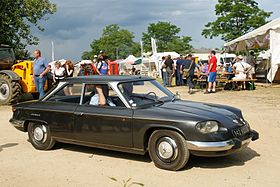This article may require cleanup to meet Wikipedia's quality standards. The specific problem is: badly referenced and inaccurate. (March 2023) |
| Panhard 24 | |
|---|---|
 | |
| Overview | |
| Manufacturer | Société des Anciens Etablissements Panhard et Levassor[1] |
| Production | 1964–1967 28,651 produced |
| Designer | Louis Bionier |
| Body and chassis | |
| Class | Mid-size |
| Body style | 2-door coupé 2-door sedan |
| Layout | Front-engine, front-wheel-drive |
| Powertrain | |
| Engine | 848 cc two-cylinder boxer motor 42 or 50 hp at 5250 or 5750 rpm |
| Transmission | 4-speed manual |
| Dimensions | |
| Wheelbase | 2,286 mm (90.0 in) or 2,550 mm (100.4 in) |
| Length | 4,267 mm (168.0 in) or 4,550 mm (179.1 in) |
| Width | 1,620 mm (63.8 in) |
| Height | 1,220 mm (48.0 in) |
| Curb weight | 840 kg (1,852 lb) (approx) |
| Chronology | |
| Predecessor | Panhard PL 17 |
| Successor | Citroën GS |

The Panhard 24 is a compact two-door coupé automobile produced between 1964 and 1967 by French manufacturer Panhard. It was powered by a front-mounted air-cooled two-cylinder boxer motor: the basic design of this unconventional engine dated back to the 1940s. In 1965, a lengthened Panhard 24 was launched and promoted as a two-door four- or five-seat saloon. Plans for a four-door version which might have enabled the car more effectively to replace the commercially successful Panhard PL 17 saloon were never implemented, however.
Although the 24 had no Panhard badged successor, a number of the features of the Citroën GS which appeared (after an unusually long gestation period) in 1970 respected Panhard traditions. The Panhard 24 may be thought of as the swan song of Panhard automobile production (since 1967 the Panhard business has concentrated on manufacturing light military vehicles).
- ^ Georgano, G.N. (1968). The Complete Encyclopaedia of Motorcars 1885 - 1968. London: Ebury Press.